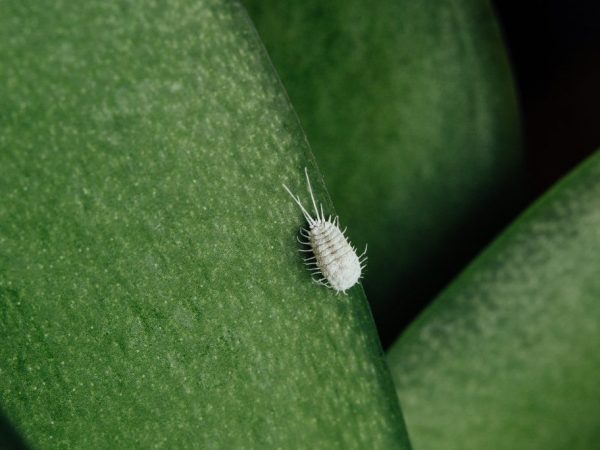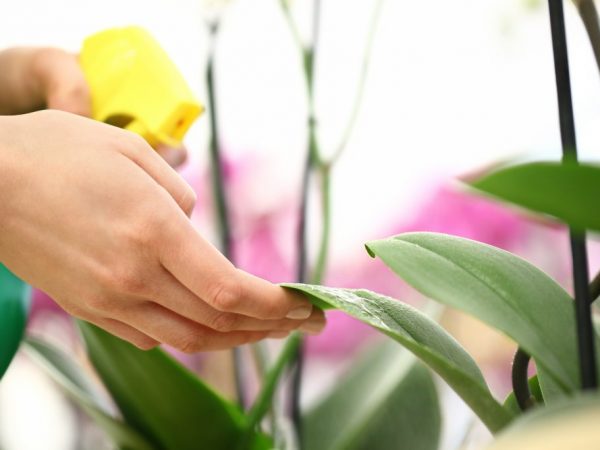Fighting mealybugs on an orchid
Harmful organisms become a problem when growing flowers in house plants. A mealybug on an orchid is capable of destroying it if the necessary measures to eliminate the pest and prevent it are not taken.

Mealybug on orchid leaves
Description of the pest
Phalaenopsis affects 2 types of these parasitic organisms: citrus and bristly. Soil varieties are parasitic on the roots. Other subspecies use succulent shoots and flower leaves as food. Because of the wax coating that covers the body of the pest, they are popularly known as hairy lice or felt lice.
Description of the appearance of the parasite:
- The body of the female is rounded. Its length reaches 3-6 mm.
- From above, the body of females is covered with white threads.
- The body size of a male mealybug is 2 mm.
- Outwardly, the male of the parasite is a winged insect with 2 outgrowths located in the back of the body.
- The larvae look like yellowish worms. They move through the leaves of the orchid, trying to find food.
Males have a short lifespan and therefore do not feed.
Females are usually stationary or move at low speed. After that, they stick to the flower in one place and are heavily nourished by it. During this process, females form a egg-laying sac of wax filaments.
Larvae move faster than adult insects until they find a place to feed. After that, they gain strength and prepare for the molting process.
The easiest way to kill parasites on orchids is at the beginning of the infestation. Sites of potential infection are carefully examined. Peduncles, foliage and young shoots are cleaned of egg sacs and female mealybugs using a gauze swab. After the plant is wiped with a cotton swab dipped in alcohol tincture of calendula.
Due to the invasion of insects, there is a high probability of developing bacterial, fungal and viral diseases. Pests are more likely to appear in highly crowded conditions.
Chemicals
It is possible to get rid of mealybugs on orchids with the help of chemicals that have a contact or intestinal effect. Juveniles are not yet covered with a protective wax coating. Because of this, the contact insecticide destroys the shell of the pest, getting on it. Due to the use of enteric chemicals, the treatment becomes more efficient. These drugs are able to remove all parasites on the plant and allow you to fight the scourge faster and more successfully.
The following pesticides and insecticides are used to treat orchids:
- Fitoverm;
- "Vertimek";
- Aktara;
- "Calypso";
- Actellik.
"Fitoverm" and "Vermitek" are drugs that have an intestinal contact method of affecting pests. Their toxicity is not as high as other chemicals used to treat flowers with mealybugs.
Aktara has a devastating effect on most of the harmful organisms that can infect phalaenopsis.A special solution is prepared to treat the plant with aktara. For its preparation, 2 g of powder is dissolved in 2.5 l of water.
Phalaenopisis treatment with Calypso insecticide quickly kills harmful organisms. It is really possible to save an orchid from a mealybug with its help, by preparing a solution of 1 liter of water and 0.5 ml of the drug.
Treatment with the Actellik chemical is used in rare cases. The main indication for use is massive damage to flowers by parasitic organisms. One ampoule of insecticide is dissolved in 2 liters of water. The prepared solution is sprayed on the leaves on both sides. Also, the root of the orchid is treated with part of the working fluid. It takes 3-4 treatments to cure it. A break of 7 days is observed between them.
If the use of the drug did not allow getting rid of the worm on orchids, it is no longer used. After a 7-10 day break, the plant is re-treated with another insecticide.

Treatment of orchids from mealybug
Folk remedies
At home, the removal of parasites in the early stages of invasion is destroyed using the following technique. The leaves of the plant are cleared of parasites, all secretions are washed off. Parts of the flower that have suffered severe damage are cut out. The scales located on the pseudobulb are also removed, and the airy tubers are wiped with a damp cotton pad. The foliage, located near the surface organ, is pushed back, after which the larvae are removed with cotton wool.
You can fight pests using folk remedies:
- 4-5 garlic cloves are infused in 0.5 liters of boiling water. The resulting infusion is sprayed over the entire flower or used to wash the foliage on both sides.
- 1 tbsp. l. young shoots of ivy are poured with a glass of boiling water. The plant is treated with chilled infusion.
- The pot is filled with water and potato skins. The contents of the vessel are brought to a boil and heating is continued for another 10 minutes. The plant is treated with a solution cooled to 40 ° C.
To combat the larvae and adults of the parasite, a soap-alcohol solution is used. It is prepared using 2 tbsp. l. 70% alcohol, 1 tbsp. l. liquid soap and 1 liter of soft water. Roots and flowers are covered to prevent the solution from getting on the surface. Colonies of the pest are subject to processing. To destroy the pest at home, the solution is applied with a brush.
Heating helps fight harmful organisms just as effectively. Care should be taken when using this method: sunbathing will burn the foliage of the flower. The mealybug on orchids is ruined by temperatures above 35 ° C. An effective measure is a shower for the plant, for which water is used at a temperature of 45-50 ° C.
Prophylaxis
The flower must be watered with a dried substrate. The watering depth is 1 cm. In case of accumulation of liquid in the sump, it is emptied. The pot containing the flower is constantly cleaned of debris and dead foliage. Also wash the shelf of pots regularly using hot water.
In the summertime, the larvae of the parasite enter the room due to gusts of wind. For this reason, the plants are periodically examined, suspicious specimens are isolated from the rest.
New flowers are quarantined: they are placed separately and carefully observed. If there is a suspicion of infection with harmful insects, the orchid is immediately treated with folk remedies or an insecticide solution.
Conclusion
Mealybug on orchids is a serious problem that needs to be dealt with in time. A florist can use folk remedies to fight insects or treat the plant using one of the mealybug drugs on orchids.


